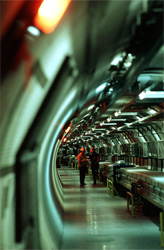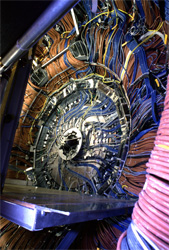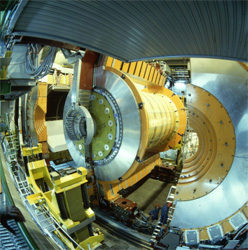Testing the Standard Model
The LEP experiments
The Large Electron Positron (LEP) collider was CERN’s flagship accelerator from 1989 to 2000. Altogether about 1500 physicists worked on experiments at LEP, on four large particle detectors called ALEPH, DELPHI, L3 and OPAL.
 This was the accelerator that put the Standard Model of particle physics through its paces. The numerous data taken by the four experiments well and truly tested the model to an incredible level of precision. The experimental results agreed with the theoretical predictions and helped to establish the Standard Model's validity. Other notable achievements at LEP include establishing that there are three types of neutrino, and setting the lower limit for the possible mass of the Higgs boson.
This was the accelerator that put the Standard Model of particle physics through its paces. The numerous data taken by the four experiments well and truly tested the model to an incredible level of precision. The experimental results agreed with the theoretical predictions and helped to establish the Standard Model's validity. Other notable achievements at LEP include establishing that there are three types of neutrino, and setting the lower limit for the possible mass of the Higgs boson.
LEP operated in two phases. In phase 1 (1989-1995) it collided electrons with positrons to produce Z bosons, the neutral carriers of the weak force. In phase 2 (1996-2000) it produced W bosons, the charged carriers.
After 11 years of operation, LEP was finally switched off in November 2000. A month later, dismantling began to make way for its successor – the Large Hadron Collider.
The detectors
The four experiments at LEP – ALEPH, DELPHI, L3, and OPAL – became the most cosmopolitan collaborations of physicists the world had ever seen at the time.
 Each of the four huge detectors consisted of layers of specialised sub-detectors, which recorded specific particles produced in the collisions. A pipe carried the electron and positron beams in opposite directions through the centre of the each detector. The surrounding sub-detectors formed concentric cylinders with 'end caps' plugging the ends to ensure that few particles escaped detection. Detector components were built by CERN’s Member States as well as in other countries, including China, Japan, and the US. When the experiment halls were ready in 1988, all the various components were brought together from around the world for final assembly.
Each of the four huge detectors consisted of layers of specialised sub-detectors, which recorded specific particles produced in the collisions. A pipe carried the electron and positron beams in opposite directions through the centre of the each detector. The surrounding sub-detectors formed concentric cylinders with 'end caps' plugging the ends to ensure that few particles escaped detection. Detector components were built by CERN’s Member States as well as in other countries, including China, Japan, and the US. When the experiment halls were ready in 1988, all the various components were brought together from around the world for final assembly.
The first results
 The OPAL experiment recorded the very first collision, at about five past midnight on 13 August 1989, and the other three experiments followed soon after. The first fully-fledged physics run began on 20 September and continued for three months. During this time, the experiments each recorded around 30 000 Z particles, enough for the first data analysis to get under way.
The OPAL experiment recorded the very first collision, at about five past midnight on 13 August 1989, and the other three experiments followed soon after. The first fully-fledged physics run began on 20 September and continued for three months. During this time, the experiments each recorded around 30 000 Z particles, enough for the first data analysis to get under way.
By the time LEP was officially inaugurated on 13 November 1989, in the presence of some 1500 guests including heads of state and ministers from all of CERN’s Member States, the first results had already been announced – the experiments had confirmed that only three types of neutrinos exist, and hence only three generations of matter particles.
Hints of new physics
LEP was originally scheduled to close at the end of September 2000, but tantalising signs of new physics led to an extension of its operation until 2 November. At the end of this period, the four experiments had observed a number of collisions that may have produced the Higgs particle (with a mass of around 115 GeV), although these events were also compatible with other known processes. The new data were not sufficiently conclusive to justify continuing to run the accelerator in 2001, which would have had inevitable impact on the construction of the Large Hadron Collider (LHC) and CERN’s scientific programme. CERN’s management decided that the best policy for the Laboratory was to proceed full-speed ahead with the LHC project.

